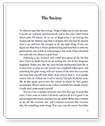Essay Instructions: Review an article for local, regional and naional events that may have an impact on a Nurse Practitioner practice and health care.
Identify how these events will affect Nurse Practitioner''s practice and health care and describe practice implications.
June 7, 2002
Tobacco Company Reneged on Youth Ads, Judge Rules
By GREG WINTER
fter vowing in a 1998 tobacco settlement to market solely to adults, the R. J. Reynolds Tobacco Company has violated the agreement by pursuing an advertising strategy that promotes youth smoking, a California judge ruled yesterday.
The company was fined $20 million.
Repeating the maxim "actions speak louder than words," the judge, Ronald S. Prager of Superior Court in San Diego, wrote that Reynolds''s public commitment to reducing youth smoking was belied by the fact that almost as many children saw its cigarette advertisements as adults.
The company places so many advertisements in magazines with "huge youth readerships," like Sports Illustrated and Rolling Stone, Judge Prager ruled, that it "strains credibility" to suggest that Reynolds did not consider how many children under 18 were exposed to its cigarettes.
The $20 million fine ordered by Judge Prager, who oversees compliance with the tobacco settlement in California, was the amount sought by the state''s attorney general, Bill Lockyer, who brought the lawsuit with help from New York, Connecticut, Maryland and Pennsylvania.
More significantly perhaps, the judge also ordered Reynolds to stop putting cigarette advertisements in magazines with a disproportionate number of teenage readers.
Judge Prager did not bar Reynolds from promoting its cigarettes in newspapers or magazines that minors might read. Instead, he instructed the company to make sure that far fewer children came across its advertisements than adults, an order that Reynolds says impinges upon its First Amendment rights.
"The only way that you can be sure that a minor is never going to be exposed to cigarette ads is if you don''t advertise at all," said Tommy Payne, a company spokesman, who said Reynolds would appeal the ruling. "That basically censors, if not bans, legitimate advertising to adults."
The decision concludes the first legal test of the tobacco settlement''s prohibition on reaching out to young people and encouraging them to smoke. That prohibition has been at once a central tenet of the encyclopedic, 300-page accord and one of its most heavily debated provisions.
The agreement between the tobacco companies and 46 states, for instance, contains no numerical guidelines for determining what constitutes singling youth out. Instead, it simply states that cigarette makers cannot "take any action, directly or indirectly, to target youth."
Judge Prager''s decision is the first to interpret what that statement means for the enforcement of the settlement. Although neither the judge nor Mr. Lockyer contend that Reynolds deliberately placed the advertisements to entice children to smoke, Judge Prager ruled that Reynolds "studiously avoided" tracking how many children read the publications.
In 1999, for example, the year after Reynolds signed the settlement, advertisements for Camel, the company''s most popular brand, reached 88.5 percent of teenagers at least 22 times, the judge ruled. In contrast, 88 percent of the company''s stated target audience, adult smokers ages 21 to 34, encountered the advertisements only about 17 times, he found.
The judge ruled that "it does not matter" whether Reynolds intended to single out children and get them to smoke. The fact that it did not adopt "reasonable measures" to shield young people from its advertisements represented a breach of the company''s responsibility to help reduce youth smoking.
Since signing the settlement, Reynolds''s major competitors have imposed stricter standards for their advertisements. Under pressure from attorneys general in several states, Philip Morris adopted the Food and Drug Administration''s suggestion not to advertise in magazines if more than two million of their readers are under 18 or if children make up more than 15 percent of their audience.
Lorillard, a unit of Loews, and Brown & Williamson, a unit of British American Tobacco P.L.C., have adopted similar standards, but only after Mr. Lockyer threatened to sue Reynolds last year did the company bring down its threshold to magazines with 25 percent of readers under 18.
Given that teenagers represent about 10 percent of the nation''s population, Mr. Lockyer and many other attorneys general accused the company of selecting magazines that "do better at reaching teens than the young adult smokers Reynolds claims it is trying to reach," according to the state''s legal briefs.
It is not the first time attorneys general have clashed with Reynolds over how to interpret the tobacco settlement, but it is arguably their biggest victory.
Last year, New York, Arizona and California sued Reynolds, with mixed results, for leaving advertisements for its NASCAR racing series on display longer than the agreement allows. Ohio unsuccessfully sued the company for distributing merchandise with its logo, another prohibition in the settlement. Last month, California won a $15 million judgment against Reynolds for handing out more than $100,000 worth of free cigarettes at public events where children were present, also a settlement violation.
Reynolds is not the only company accused of directing advertising to young people. In a study released this week, the Massachusetts Department of Health said UST Inc., the nation''s largest snuff maker, had increased its advertising in teenager-focused magazines to $9.4 million in 2001 from $3.6 million in 1997 since signing a settlement of its own.
Copyright 2002 The New York Times Company | Permissions | Privacy Policy Advertisement


